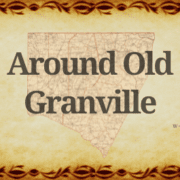TownTalk: Around Old Granville: History Of Brookston, Greystone And Chalk Level
If you’ve ever wondered about those two small rock buildings that you see when you’re driving out Warrenton Road on the way to Brookston, North Carolina Room Specialist Mark Pace may have some information that will help.
In the late 1800’s when John Wesley Pegram was going gangbusters as a stone mason, the area where those two one-room structures currently sit were situated on the main North-South route – predating even U.S. Hwy 1.
And Pegram constructed those two buildings as advertising for his considerable abilities, Pace said on Thursday’s TownTalk segment of Around Old Granville.
Anyone who wants to see the “crowning achievement” need look no further than the Methodist Church in downtown Henderson.
Pegram lived in the Brookston community and plied his trade in the late 1800’s. In fact, Pace said, he had his own private quarry nearby. But his quarry wasn’t the only one in the area of Brookston, Chalk Level and Greystone.
There’s been a quarry in operation at Greystone for close to 200 years, and although it’s changed ownership over the years, Greystone may be one of the oldest businesses in the area.
It makes sense that the Greystone quarry has been around since the 1830’s, Pace noted, because that’s about the same time that the Raleigh & Gaston Railroad was being constructed. And just think of all the gravel that goes into making up a rail bed.
There’s a string of quarries along the “Ridge Way,” the flat area that wends its way along the general route of U.S. 1 where railroad planners laid tracks. There’s a quarry in Wake Forest, another in Kittrell, then there’s Greystone and also one at Wise, Pace noted.
Folks in the Greystone, Brookston and Chalk Level communities had high hopes that their sleepy little area would prosper once the railroad came through.
And it almost happened.
Until a wealthy landowner named Lewis Reavis, who owned property near where the old courthouse and former library sit downtown, lured the railroad to Henderson in the mid-1830’s by offering rights-of-way and property on which to build a depot.
It made all the difference. Henderson became incorporated just a few years later, in 1841, and Chalk Level died off.
But the Chalk Level area of what is now Vance County has one of the highest elevations in the area – some 500 feet above sea level – and that’s why a fire tower is located there, as well as a signal tower for the former WHNC radio station.
Just down the road from Chalk Level is Brookston Baptist Church, which Pace said is the oldest African American church around. Founded by the Hayes, Hawkins and Bing families, it could have been established as early as 1858, he said. “But I know it was there by the 1870’s.”
Also nearby is Carver Elementary School, was built in 1954 – the same year as the U.S. Supreme Court ended racial segregation with its ruling in Brown v. Board of Education.
The main speaker at the dedication of the school was Shiloh Church’s pastor, the Rev. John R. Dungee, who is an ancestor of Tony Dungee, the former pro football coach-turned analyst.
First Lady Barbara Bush visited Carver in 1990, when the school hosted a program that offered teen mothers a chance to earn their high school equivalency diplomas while their children attended school.
CLICK PLAY!

